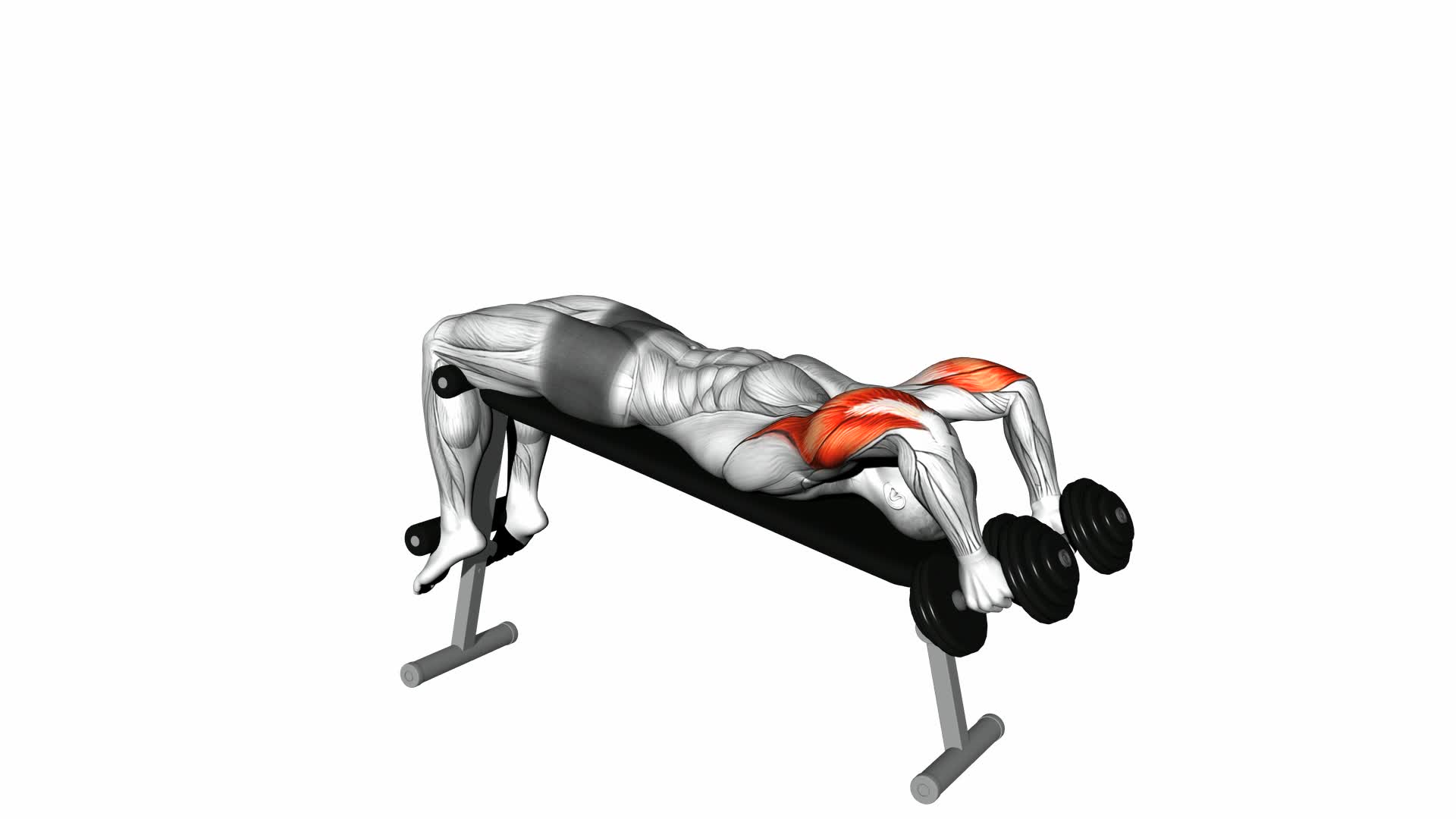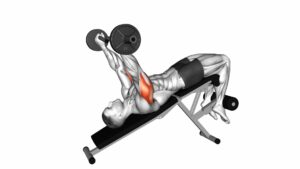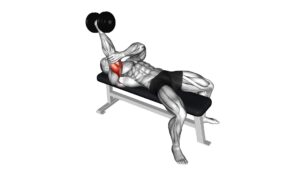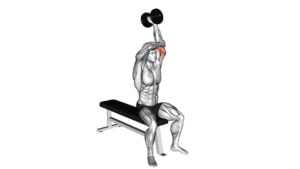Dumbbell Decline Triceps Extension – Video Exercise Guide & Tips

Looking to target your triceps and build strength? Check out the Dumbbell Decline Triceps Extension.
Watch This Exercise Video
This exercise is a great way to isolate and work your triceps muscles. In this video exercise guide, you'll learn the proper form and technique for performing the exercise, as well as tips for maximizing its effectiveness.
Whether you're a beginner or advanced fitness enthusiast, this exercise has variations and modifications to suit different fitness levels.
Let's get started and level up your triceps game!
Key Takeaways
- The dumbbell decline triceps extension is an effective exercise for increasing triceps strength and definition.
- Proper form and technique, such as keeping elbows close to the head and avoiding common mistakes, are crucial for maximizing the effectiveness of the exercise.
- Breathing techniques, like exhaling during the extension and inhaling during the lowering phase, help stabilize the core and improve exercise efficiency.
- Using appropriate weight, starting with lighter weights and gradually increasing as strength improves, is important to maintain proper form and avoid injury.
Benefits of the Dumbbell Decline Triceps Extension
You will experience increased muscle strength and definition in your triceps when you regularly incorporate the dumbbell decline triceps extension into your workout routine. This exercise specifically targets the triceps, which are the muscles located at the back of your upper arm. By performing the dumbbell decline triceps extension, you can effectively isolate and engage these muscles, leading to enhanced strength and definition.
One of the key benefits of this exercise is its ability to provide a greater range of motion compared to other triceps exercises. The decline position allows for a deeper stretch of the triceps, which can stimulate more muscle fibers and promote better muscle growth. Additionally, this exercise also helps to improve overall triceps stability and control.
The dumbbell decline triceps extension offers variations and modifications that can be incorporated to further challenge and target different areas of the triceps. For instance, you can use different grip positions, such as an overhand or underhand grip, to emphasize different parts of the triceps. You can also adjust the weight of the dumbbells to increase or decrease the intensity of the exercise.
Incorporating the dumbbell decline triceps extension into your workout routine can provide numerous benefits for your triceps. Its ability to target the triceps effectively, provide a greater range of motion, and offer variations and modifications make it a valuable exercise for building strength and definition in your triceps.
Equipment Needed for the Exercise
To perform the dumbbell decline triceps extension, you'll need some required exercise equipment. The good news is that the equipment needed for this exercise is minimal.
All you need are a set of dumbbells and a decline bench.
Required Exercise Equipment
To perform the Dumbbell Decline Triceps Extension, you'll need some exercise equipment. Here are the items you'll need:
- Dumbbells: Choose a weight that challenges your triceps but still allows you to maintain proper form. Start with a weight that you can comfortably lift for 8-12 repetitions.
- Bench: You'll need a decline bench to perform this exercise. Make sure the bench is secure and stable before you start.
- Spotter: It's always a good idea to have a spotter when performing exercises that involve heavy weights. They can assist you if you need help or if you reach muscle failure.
If you don't have access to dumbbells, you can use alternative equipment options like resistance bands or kettlebells. Additionally, if you don't have a decline bench, you can modify the exercise by using an incline bench or stability ball.
Remember to adjust the weights and equipment according to your fitness level and preferences.
Minimal Equipment Requirements
To perform the Dumbbell Decline Triceps Extension, you'll only need minimal exercise equipment. As the name suggests, this exercise requires a dumbbell, which is a versatile piece of equipment commonly used for various triceps workouts.
The dumbbell should be a weight that challenges your triceps muscles but allows you to maintain proper form throughout the exercise. It's recommended to start with a lighter weight and gradually increase as you become more comfortable and stronger. Make sure to choose a dumbbell that you can easily grip and control.
Now that you know the minimal equipment requirements for this exercise, let's move on to the next section, which will cover the proper form and technique for performing the Dumbbell Decline Triceps Extension.
Proper Form and Technique for Performing the Exercise
To perform the dumbbell decline triceps extension with proper form and technique, it's crucial to focus on the positioning of your elbows throughout the exercise. Keep your elbows close to your head and avoid flaring them out to the sides.
Additionally, pay attention to your breathing techniques to maintain stability and control during the movement.
Lastly, be aware of common mistakes such as using excessive weight or swinging the dumbbells, and make sure to avoid them for an effective and safe workout.
Elbows Positioning During Exercise
Keep your elbows close to your body while performing the dumbbell decline triceps extension. This is crucial for maintaining proper form and maximizing triceps activation during the exercise.
Here are three reasons why proper elbow positioning is important:
- Stability: Keeping your elbows close to your body provides stability throughout the movement, reducing the risk of injury and allowing you to lift heavier weights safely.
- Targeting the Triceps: By keeping your elbows tucked in, you ensure that the primary focus of the exercise remains on the triceps. This allows for better muscle engagement and development.
- Range of Motion: Proper elbow positioning allows for a full range of motion during the exercise, ensuring that the triceps are fully stretched and contracted, leading to optimal muscle growth.
Breathing Techniques for Stability
Maintain stability and optimize your form and technique during the dumbbell decline triceps extension by focusing on proper breathing techniques. Utilizing the correct breathing techniques not only helps you maintain stability throughout the exercise but also provides additional benefits for your overall performance.
Proper breathing helps stabilize your core and enhances your body's ability to generate power, allowing you to lift heavier weights with better control.
When performing the dumbbell decline triceps extension, exhale as you extend your arms upward, and inhale as you lower the dumbbells back to the starting position.
This breathing pattern helps engage your core muscles, maintain stability, and maximize the effectiveness of the exercise.
By incorporating these breathing techniques, you can ensure proper form and achieve optimal results.
Now, let's move on to the next section and discuss common mistakes to avoid.
Common Mistakes to Avoid
When performing the dumbbell decline triceps extension, be mindful of these common mistakes to ensure proper form and technique for the exercise.
- Improper elbow positioning: One of the most common mistakes is allowing your elbows to flare outwards during the movement. This not only puts unnecessary strain on your shoulders but also reduces the effectiveness of the exercise. Keep your elbows tucked in close to your head throughout the entire movement.
- Using excessive weight: Another mistake is using weights that are too heavy, compromising your form and putting your joints at risk. Start with lighter weights and focus on mastering the proper form before progressing to heavier loads.
- Lack of control: Many people tend to rush through the exercise, sacrificing control and proper muscle activation. Slow down the movement, focusing on the contraction and extension of your triceps muscles.
Tips for Maximizing the Effectiveness of the Exercise
To maximize the effectiveness of the dumbbell decline triceps extension, incorporate proper form and focus on engaging your triceps throughout the entire movement. By doing so, you can ensure that you're maximizing results and effectively activating your triceps muscles.
First and foremost, it's important to maintain a stable and controlled motion throughout the exercise. Avoid using momentum or swinging the weights, as this can take the focus away from your triceps and reduce the effectiveness of the exercise. Instead, keep your body steady and use slow, controlled movements to fully engage your triceps.
Additionally, make sure to fully extend your arms at the top of the movement. This will help to fully activate your triceps and ensure that you're getting the most out of each repetition. It can be tempting to only partially extend your arms, but doing so will limit the effectiveness of the exercise.
Lastly, remember to breathe properly throughout the exercise. Exhale as you extend your arms and inhale as you return to the starting position. Proper breathing technique will help you maintain control and maximize the effectiveness of the exercise.
By following these tips, you can ensure that you're maximizing results and effectively activating your triceps muscles during the dumbbell decline triceps extension.
Now, let's move on to the next section and discuss common mistakes to avoid while doing the exercise.
Common Mistakes to Avoid While Doing the Exercise
Avoid these 3 common mistakes while performing the dumbbell decline triceps extension for optimal results:
- Incorrect elbow positioning: One common mistake is allowing your elbows to flare out to the sides during the exercise. This puts unnecessary strain on your shoulders and reduces the effectiveness of the triceps workout. Instead, keep your elbows close to your body and pointed towards your feet. This will ensure that the triceps muscles are being properly targeted.
- Poor breathing techniques: Another mistake is forgetting to breathe properly during the exercise. Holding your breath can increase blood pressure and reduce oxygen flow to your muscles, limiting their ability to perform at their best. Remember to exhale as you extend your arms and inhale as you lower the dumbbells back to the starting position. This will help maintain proper oxygen flow and optimize your triceps workout.
- Using too much weight: Many people make the mistake of using weights that are too heavy for them, sacrificing proper form and risking injury. Start with lighter weights and focus on maintaining proper form throughout the exercise. As you build strength and confidence, you can gradually increase the weight.
By avoiding these common mistakes, you can ensure that you're getting the most out of your dumbbell decline triceps extension.
Now, let's explore some variations and modifications to try for different fitness levels.
Variations and Modifications to Try for Different Fitness Levels
For different fitness levels, you can try various modifications and variations of the dumbbell decline triceps extension exercise. These variations will allow you to tailor the exercise to your specific needs and abilities, ensuring that you're challenging yourself while also minimizing the risk of injury.
One variation you can try is using different weights for the dumbbells. If you're a beginner or have limited upper body strength, you can start with lighter weights and gradually increase the weight as you become stronger. On the other hand, if you're more advanced, you can use heavier weights to intensify the exercise and further challenge your triceps.
Another modification you can make is adjusting the angle of decline. By changing the angle of the decline bench, you can target different parts of your triceps. For example, a steeper decline will emphasize the long head of the triceps, while a less steep decline will engage the lateral and medial heads.
Additionally, you can try performing the exercise with a single dumbbell instead of two. This unilateral variation will help improve your stability and balance while also providing a different stimulus to your triceps.
Remember to always listen to your body and adjust the exercise according to your fitness level. By incorporating these variations and modifications into your dumbbell decline triceps extension routine, you can continue to challenge yourself and make progress towards your fitness goals.
Frequently Asked Questions
How Many Sets and Repetitions Should I Do for the Dumbbell Decline Triceps Extension?
For the dumbbell decline triceps extension, you're probably wondering how many sets and repetitions to do. Well, sets and repetitions can vary depending on your fitness level and goals.
A good starting point is 3 sets of 8-12 repetitions. However, you can adjust the sets and reps based on your comfort and progress.
If you don't have dumbbells, you can try alternative exercises like triceps dips or push-ups to target your triceps.
Can I Use a Barbell Instead of Dumbbells for This Exercise?
Yes, you can definitely use a barbell as a substitute for dumbbells in this exercise. While dumbbells offer certain benefits like improved stability and individual arm movement, using a barbell allows you to lift heavier weights and engage more muscles.
However, it's important to maintain proper form and control throughout the exercise to avoid any injuries. Remember to consult with a fitness professional to ensure you're using the correct technique when using a barbell for the decline triceps extension.
Is It Necessary to Have a Decline Bench to Perform This Exercise, or Can I Use a Regular Flat Bench?
You don't necessarily need a decline bench to perform this exercise. A regular flat bench can also be used. The important thing is to maintain proper form and control throughout the movement.
Focus on targeting your triceps by extending your arms fully and squeezing at the top of each repetition. Aim for a suitable number of repetitions and sets that challenge your muscles without compromising your form.
Can I Do This Exercise if I Have a Shoulder Injury?
If you have a shoulder injury, it's important to modify your exercises to avoid further strain.
The Dumbbell Decline Triceps Extension may not be suitable for you as it puts pressure on the shoulders.
Instead, consider alternative triceps exercises that are less stressful on the shoulder joint, such as triceps pushdowns or dips.
Consult with a professional or physical therapist to determine the best course of action for your specific injury.
How Long Should I Rest Between Sets When Doing the Dumbbell Decline Triceps Extension?
When doing the dumbbell decline triceps extension, it's important to consider rest periods between sets. Resting allows your muscles to recover and prepare for the next set.
The length of your rest periods depends on your goals and fitness level. Generally, a rest period of 30-90 seconds is recommended for strength training. However, if you're focusing on endurance, shorter rest periods of 10-30 seconds may be more suitable.
Adjust the rest periods according to your weight selection and desired outcome.
Conclusion
In conclusion, the dumbbell decline triceps extension is a highly effective exercise for targeting and strengthening the triceps muscles. By maintaining proper form and using the appropriate equipment, you can maximize the effectiveness of this exercise.
Additionally, being aware of common mistakes and variations can help you tailor the exercise to your fitness level. Incorporating this exercise into your triceps workout routine can lead to significant gains in strength and muscle definition.

Author
Years ago, the spark of my life’s passion ignited in my mind the moment I stepped into the local gym for the first time. The inaugural bead of perspiration, the initial endeavor, the very first surge of endorphins, and a sense of pride that washed over me post-workout marked the beginning of my deep-seated interest in strength sports, fitness, and sports nutrition. This very curiosity blossomed rapidly into a profound fascination, propelling me to earn a Master’s degree in Physical Education from the Academy of Physical Education in Krakow, followed by a Sports Manager diploma from the Jagiellonian University. My journey of growth led me to gain more specialized qualifications, such as being a certified personal trainer with a focus on sports dietetics, a lifeguard, and an instructor for wellness and corrective gymnastics. Theoretical knowledge paired seamlessly with practical experience, reinforcing my belief that the transformation of individuals under my guidance was also a reflection of my personal growth. This belief holds true even today. Each day, I strive to push the boundaries and explore new realms. These realms gently elevate me to greater heights. The unique combination of passion for my field and the continuous quest for growth fuels my drive to break new ground.







